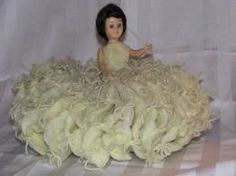Anne’s Biddies

Dairy filter doll
I often write about the challenges of healthcare in Vermont and its potential to better serve Vermonters. I’ve been haunted recently by the memory of a nurse I knew as a child growing up in Morrisville. She worked in the old wood-frame Copley Hospital built in 1932. The house my father built in 1948 was just up the street. This is her story as I remember it. What does it teach us about the heart of healthcare and the Christmas Season?
It’s the second Sunday of Advent and Anne Stone braces for Christmas. Anne has been a nurse at the hospital for 48 of her 69 years. As a young woman, she trained at the Jeanne Mance School of Nursing in Burlington and then served next door as a candy-striper at the Bishop DeGoesbriand Hospital in the late ’50s when the twin towns of Winooski and Burlington shared three hospitals. In 1959, she returned to her hometown hospital in the Northeast Kingdom and began working as a nurse for 85 cents an hour when it was still a four-story wood firetrap enmeshed in countless fire escapes.
Most of the time, Anne loves her work. She has opinions about many of the “advances” in health care over the years, but she keeps them to herself. Anne’s life as a nurse has in some ways been made harder because she knows many of the life stories of her patients. After nursing in the small Vermont town for half a century, she can often predict an inhabitant’s admission to the week if not the day. She knows sickness is a continuum that eventually ends with an admission. The crises that lead to hospitalization can be acute, like a farm accident or a stroke, or stem from chronic diseases like emphysema, diabetes, or anemia, but she knows from experience that there are few real accidents in life and that most illness has a long backstory: if you know the person and their story, you can usually predict their arrival at the hospital door.
Weather, daylight, and economics all play parts in the ebb and flow of hospital admissions. Anne chuckles to herself as she dutifully fills out the many data surveys and reports that are a routine part of her life as a charge nurse. The questions so often miss the larger points that affect real lives, the intangibles that have nothing to do with vital signs, quality metrics, patient surveys, and the like. Anne can often predict the ebb and flow of admissions by the weather, the time of year and the surge of gossip that may engulf someone in the community.
“That bunch on Tiny’s neck’s gettin’ bigger.”
“Did you hear? Peavine’s back on the sauce.”
Anne can tell you within a week or two when he will show up at the front desk. He reels in, always during the day, and collapses on the floor. He’s then rushed to emergency where he’s diagnosed with acute alcoholism, “weaned and cleaned,” rehydrated, put to bed for a night, and then discharged to his 93-year-old mother, who again commits him to a life of sobriety, whereupon they disappear in a taxi together with Peavine staring at his shoes and his mother staring straight ahead.
Then there’s Glenna Farr, a distant cousin. For 14 years, Glenna has had “the sugar.” She’s managed it, more or less, with diet and insulin. Exercise was never an option. Glenna grew up on a farm, where one’s cunning was applied to finding easier ways to accomplish hard work not harder ways or ways to extend work. Exercise was, and remained, counterintuitive. But then again so did eating foods like green vegetables, whole wheat toast without butter, and sugarless cereals with skimmed milk.
For years, Glenna’s taken her annual turn hosting the ladies of the “Uplift Club” for their monthly meeting. Although the meeting has a set agenda in which members share ways to enhance their economic position in the community by learning crafts and skills such as crocheting, raising hens and selling eggs, custom baking, quilting, or crafting such things as tongue-depressor lampshades or milk-filter doll gowns, a meeting’s true success is determined by the quality and nature of the goodies served during the “fellowship hour” that follows. These become the principal topic of conversation and certainly hold sway in later gossip about how the meeting went.
When her turn came, Glenna would carefully plan what to serve, poring over cookbooks in the Morrisville Library to uncover novel delicacies that will enthrall her friends, dominate conversation, and leave an enduring and positive impression on her guests. Unfortunately, every recipe involves large quantities of sugar, flour, butter, and other rich ingredients that are denied her as a diabetic. As she combines the forbidden ingredients, slides them into the oven, and then inhales the beguiling aroma, she firmly resolves to abstain for the sake of her health.
The stress of preparing for the meeting, the scrutiny by other ladies of her shabby furniture and lackluster china, the question of how her efforts will be judged always seem to overwhelm her prior commitment to abstinence and, like her fellow members, she tucks into the lemon meringues that have held their teardrop shapes so well and the exotic macaroons which prove to be a big hit.
The next day, Glenna will be admitted to the emergency room in a diabetic relapse. Anne would have advised ER staff of her impending admission and procedures would be followed such that Glenna could leave the following day after a night of close blood-sugar monitoring.
Christmas was the most difficult time of year at the hospital. It seemed to staff as if half the town’s personal stories came to some sort of head and the stoicism of small-town life somehow unraveled. The arrival of bitter cold days with little or no sunlight, forced holiday largesse that only those with a decent job could afford, and the often painful intimacy of jovial relatives descending on them all pushed some folks to their limits. Anne saw it coming each year and she would recall her father’s oft-repeated weather admonition “red sky in the morning, sailors take warning,”
There would be a bloom of dormant alcoholics who usually managed to keep their lives under some degree of control, but in the waning light of December would toss caution to the winds and imbibe until either a vehicle, a relative, or their pastor intervened and they would end up in the hospital, as the nearest jail was 22 miles away.
The chronically ill, who had to maintain some form of dietary, pharmaceutical, or bedrest regimen, would suddenly throw over the traces and do as they pleased.
Townsfolk and farmers who had never managed to maintain their place in the town’s fragile economy might have accidents. A broken leg or arm, a sprain or dislocation was a swift ticket to a bed and gentle care, surcease for a few days from the hardscrabble monotony of trying to survive.
Anne’s favorites, however, were her “biddies,” elderly, frail women, many of whom lived alone or in back rooms where their families tried to care for them — grandmothers, widowed aunts, or mothers patiently counting out their days. Few men in town seemed to endure deep into old age. Especially poignant for Anne was the number of “children” in their seventies living on assistance while having to care for ailing mothers or aunts in their nineties. Anne saw the exhaustion in the aged, craggy faces of these women and knew the harsh toll it took on them to be caring for an even older mother, at an age when they themselves might expect to be cared for.
Her biddies begin arriving after Thanksgiving, some slumped in wheelchairs, others shuffling slowly in in slippers, most escorted by embarrassed relatives. Reasons for their admission were varied, some real, some fabricated. It was the only time of year when Anne played her respected hand with the hospital administration.
In an unspoken détente, Anne would be given almost total control over available beds during Christmas. Her prescient knowledge of admissions trends enabled her to parse out beds to her biddies while ensuring adequate capacity for the few real crises like ski and car accidents, premature births, and coronaries.
Among all the fragile holiday visitors, Anne’s favorite is Elise Desrochers, who every year arrives just a day or two before Christmas and usually leaves on Christmas afternoon. She shuffles in slowly on the arm of her daughter Cecile. Elise worked for 34 years at the local dry goods store as a clerk in the fabric department before they closed down. Over the eight years she’s been coming, Mme. Desrochers’s complaints have ranged from “hip pains” to “female troubles.” She is 96 and, although great attention is paid to her symptoms, they’re nondescript enough to require only “observation and a few days of bedrest.” Installed in her hospital bed with her lace nightcap framing an angelic smile, she looks to Anne wraithlike, weightless. She hardly makes a bump under the fresh-pressed hospital sheets.
Ginnie Bettis always arrives in a wheelchair with her red holiday nightie and a stained cotton coat, pushed by her 74-year old son Arthur, who has cared for her since he was 34 when she became disabled with a mild form of muscular dystrophy. Ginnie always arrives triumphantly, usually on the 21st, and is greeted warmly by the nursing staff. This year she brings peanut butter chocolate balls for the staff. These were given to her by her friend Molly Mudgett, but Ginnie’s allergic to peanuts and never has the heart to tell Molly, as it is all Molly knows how to make.
Yvette Courchaine is an altogether different quantity and generally means trouble. A large imperious woman of French and Indian descent, she is usually wheeled in in her rolling throne by a hard-drinking neighbor, Ti-Jean Ferland. Ti-Jean is only a few years younger and inhabits a badly tilted trailer next to Yvette’s. A few years back when the Overseer of the Poor asked him if he wanted his rented trailer leveled, he answered only that “he purfurs it how it be,” and “wants for exercise to keep from “porkin’ up like Yvette là-bas.” Ti-Jean looks after Yvette when it doesn’t interfere with his drinking and brings her into the hospital each year for her “tune up.”
There are four or five others who usually arrive about the same time. Each year one or two do not show up and others arrive to take their place, but Anne knows who and why beforehand. No one counts the days or initiates “discharge planning,” since the people who bring them in will show up after Christmas to fetch them home.
Anne knows these women and their lives well. She believes it to be her privilege to make room for them and care for them during Christmas. To her, Christmas is a time when women who have lived this long should sleep in warm beds with clean sheets, have young attendants ask if they are comfortable and serve them hot meals or help them to the bathroom if need be. It’s a time for ladies who have reached this age to peruse a Ladies Home Journal or just lie back and revel in the smell of freshly laundered sheets and daydream of what might have been.

